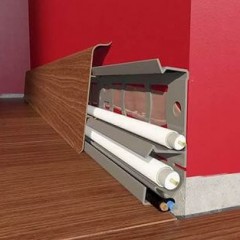How to install an end sleeve on a cable
What tools are needed
There are specially prepared kits for electricians, which include the following tools and accessories:
- fitter’s cutting knife;
- card brush;
- hacksaw with spare blades;
- pliers;
- hammer;
- file;
- screwdriver;
- roulette;
- tester (voltage indicator);
- gas burner or blowtorch.
This is the smallest set allowing you to complete the installation of the cable termination.
Installation procedure
The installation of the cable box (as in the photo below) must be carried out in accordance with the manufacturer's instructions. It is intended for terminating power cables and for connecting them to terminal devices. Depending on the number of cable cores, products for terminating 3, 4 and 5 core cables are produced. Dielectric composition: for paper and plastic insulation.
The installation of the end coupling must be carried out by a trained worker. In the conditions of large cities, for personnel carrying out installation of end couplings, it is necessary to undergo additional training in a special training center. After completing such courses, the employee receives permission to work in an urban setting.
Before starting the installation, it is necessary to check the conformity of the cable and the material available. The industry produces products for the installation of cable lines of various sections and the number of cores.
The procedure is as follows:
- Slide the cuff onto the unfinished cable.
- Carry out the cable cutting, observing the dimensions: the length of the core, according to the installation requirements, is 300-800 mm, depending on the requirements for connection, belt insulation - 25, sheath - 120, armor - 60, then - cover. After cutting, dissolve the veins, remove the printed paper.
- Prepare the tube cores in size and put them on the cores, pushing them to the end. Use a torch to shrink the tubes, starting to warm up from the base of the cable.
- Heat the cable sheath to a temperature of about 60-70 degrees, clean it of possible influxes, smudges, insulating substance, degrease.
- Put a glove on a warm shell, passing it through the veins, push them apart.Warm up the glove from the middle to the base of the cable, monitoring the quality of shrinkage. After that, warm the glove from the middle to the fingers.
- Wear colored cuffs on the cores.
- The next stage of installation is very important, because the further operation of the cable depends on it. Cut the ends of the cores by the size of the depth of the tip itself, into which the cores will be mounted. Strip the bare end of the conductor to a metallic luster, insert the stripped end into the hole in the tip and tighten the tip bolt with a wrench. The connection is considered reliable provided that the stripped end of the cable snugly fits with the tip and if the bolt head breaks when it is twisted.
- Warm the tip to a temperature of 60-70 degrees, push the colored cuff and shrink it (carry out such actions with all the cores).
- The next stage of installation is the installation of a grounding conductor. To install the grounding conductor without soldering, strip the cable sheath from dirt, dielectric, oxide 30-35 mm in size. Place a special grater on it and an earth wire to it. This wire must be brought to the side of the previously prepared ends. From the available kit, take a special pressure spring and make a turn, pressing the ground wire to the grater, turn the wire in the opposite direction and wrap the cable with the remaining pressure spring. The ground conductor must be firmly pressed against the sheath. If the technology provides for grounding by soldering, perform it according to the process chart.
- Slide the cuff over the glove and seat it with the burner. Warming up from gloves to the edge.
The cable termination assembly is complete. Further steps for testing, connecting the finished product should be carried out only after the cooling of the shrink elements and the cable itself.
The video tutorial below demonstrates how to install an end sleeve on a cable:
After the work performed, the contractor must conduct a test of the coupling by the worker, as well as increased voltage to check the quality of the work performed. According to the test results make up the act. A sample certificate for cable couplings can be found in regulatory documents of energy supervision.
In order to strengthen the responsibility of the contractor during the installation of end couplings, the customer must be nearby and control the quality directly on the site. Based on the results of the work performed, an act is drawn up. Regardless of the customer’s opinion and mood, the contractor is responsible for the correct execution of the work and commissioning of the cable line.
Here, with this technology, the installation of cable terminations is carried out. We hope that our step-by-step instruction with a video example helped you understand this issue!
It will be useful to read:








